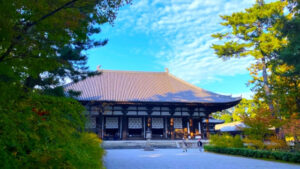Nijo Castle, located in the heart of Kyoto, Japan, is a magnificent historical site that offers a glimpse into the country’s rich past. Known as “Nijojo” in Japanese, this castle is a testament to the architectural prowess and artistic sensibilities of the Edo period. It is a UNESCO World Heritage Site and a must-visit for anyone exploring the cultural treasures of Kyoto.
History of Nijo Castle
Nijo Castle was built in 1603 by Tokugawa Ieyasu, the founder of the Tokugawa Shogunate, a feudal military government that ruled Japan for over 260 years. The castle was later expanded by Ieyasu’s grandson, Tokugawa Iemitsu, with the addition of some structures transferred from Fushimi Castle. The castle served as the Kyoto residence of the Tokugawa Shoguns until the end of the shogunate in 1867.
Architecture and Design
The castle complex spans approximately 275,000 square meters and is divided into two concentric rings of fortifications, the Ninomaru Palace, the ruins of the Honmaru Palace, various support buildings, and several beautiful gardens.
The Ninomaru Palace, the main attraction, is a stunning example of Momoyama architecture, adorned with intricate wood carvings and gold leaf. The palace rooms are decorated with elegant sliding doors (fusuma) and wall paintings by prominent artists of the Kano school. One of the unique features of the palace is the “nightingale floors” (uguisubari), designed to chirp like birds when walked upon to alert the presence of intruders.
The Honmaru Palace, although mostly in ruins, still houses a garden with a pond, where the original keep once stood. The garden is a beautiful example of Japanese landscape design, with manicured trees, stone lanterns, and a teahouse.
Practical Informations for a Seamless Visit.
- By Subway: The closest subway station to Nijo Castle is Nijojo-mae Station on the Tozai Line. The castle is just a short walk from the station.
- By Bus: City buses number 9, 50, and 101 run from Kyoto Station to Nijo Castle. The journey takes about 20 minutes and costs 230 yen. The castle is a short walk from the Nijojo-mae bus stop.
- By JR Train: If you are coming from Kyoto Station, you can take the JR Sagano Line (also known as JR Sanin Line) to Nijo Station. The castle is a 15-minute walk from the station.
- By Foot: If you are staying in central Kyoto, you can also reach Nijo Castle on foot. The walk from the downtown Kyoto area (around Shijo-Kawaramachi) to Nijo Castle takes about 20-30 minutes.
Accomodations
- Onyado Nono Kyotoshichijo Natural Hot Springs
- Located in Central Kyoto, this spa hotel is within a 10-minute walk of Kyoto Station Building and Kyoto Tower.
- Offers a full-service spa, a restaurant, and a sauna.
- Average nightly price: $105.26.
- Hyatt Regency Kyoto
- Located in Higashiyama Ward, this luxury hotel is within 1 mi (2 km) of Sanjusangen-do Temple, Kiyomizu Temple, and Kyoto Tower.
- Offers 3 restaurants, a full-service spa, and a health club.
- Average nightly price: $291.02.
- Hotel Kanra Kyoto
- Located in Central Kyoto, this spa hotel is within a 10-minute walk of Higashi Honganji Temple, Shoseien Garden, and Kyoto Tower.
- Offers a full-service spa, a restaurant, and massage/treatment rooms.
- Average nightly price: $209.37.
Conclusion
Nijo Castle is more than just a historical monument; it’s a journey into Japan’s past, offering insights into the country’s history, culture, and art. Whether you’re a history buff, an art lover, or a traveler seeking unique experiences, Nijo Castle in Kyoto is a destination that should not be missed.









